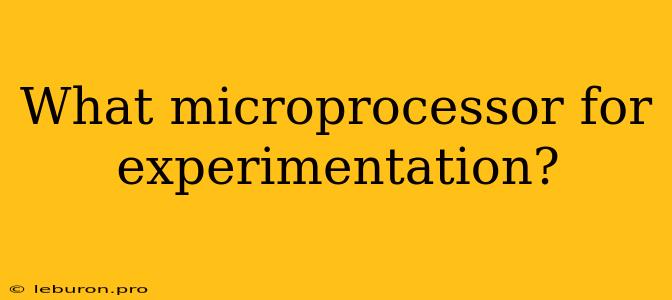The world of microprocessors is vast and diverse, offering a plethora of options for hobbyists and professionals alike. When embarking on a journey of experimentation, selecting the right microprocessor can be a daunting task. There are numerous factors to consider, including your project requirements, budget, experience level, and learning goals. This article will guide you through the process of choosing a microprocessor for your experimentation endeavors, highlighting key considerations and providing recommendations for popular choices.
Understanding Microprocessors
Before diving into the selection process, it's essential to have a fundamental understanding of microprocessors. At its core, a microprocessor is a complex integrated circuit (IC) that executes instructions stored in memory. It serves as the brain of a computer system, controlling and managing all operations. Microprocessors are characterized by their architecture, which defines how they process data, and their instruction set, which dictates the specific commands they can execute.
Essential Considerations for Choosing a Microprocessor
1. Project Requirements:
The first and foremost factor is the specific requirements of your project. What tasks will your system perform? What are the processing demands? For instance, a simple project like controlling LED lights may require a basic microprocessor with limited processing power, while a more complex project involving image processing or robotics will demand a more powerful and sophisticated chip.
2. Budget:
Microprocessors come in a wide range of prices, from a few dollars to hundreds of dollars. Your budget will play a significant role in narrowing down your choices.
3. Experience Level:
The complexity and learning curve of different microprocessors vary greatly. If you are a beginner, a user-friendly option with ample documentation and a supportive community is recommended. Experienced developers may prefer a more advanced microprocessor that offers greater flexibility and control.
4. Development Environment and Tools:
The availability of development tools, such as compilers, debuggers, and libraries, is crucial for programming and testing your microprocessor. Ensure that a robust development ecosystem exists for your chosen chip.
5. Availability and Support:
Choose a microprocessor that is readily available from reputable suppliers and has a strong community for support. Access to documentation, tutorials, and online forums can be invaluable when encountering challenges.
Popular Microprocessor Options for Experimentation
1. Arduino:
Arduino is a popular choice for beginners due to its ease of use and wide range of development resources. Arduino boards are based on AVR microcontrollers from Atmel (now part of Microchip Technology) and feature a simple programming language called Arduino IDE. The platform boasts a vast community of users, numerous projects, and extensive documentation.
2. Raspberry Pi:
Raspberry Pi is a single-board computer (SBC) that has gained immense popularity in recent years. It features a powerful ARM processor, ample memory, and numerous I/O interfaces, making it suitable for a wide array of projects, including robotics, home automation, and multimedia applications.
3. STM32 Microcontrollers:
STM32 microcontrollers from STMicroelectronics are known for their versatility, high performance, and wide range of options. They offer a vast selection of peripherals, such as timers, analog-to-digital converters (ADCs), and digital-to-analog converters (DACs), making them suitable for complex applications.
4. ESP32/ESP8266 Microcontrollers:
ESP32 and ESP8266 are popular Wi-Fi-enabled microcontrollers from Espressif Systems. Their built-in Wi-Fi connectivity makes them ideal for internet-connected projects, such as smart home devices, IoT applications, and wireless communication systems.
5. Texas Instruments MSP430 Microcontrollers:
Texas Instruments MSP430 microcontrollers are renowned for their low-power consumption, making them suitable for battery-powered applications and embedded systems. They offer a range of options with varying performance levels and peripherals.
6. PIC Microcontrollers:
PIC microcontrollers from Microchip Technology are another popular choice for embedded applications. They feature a wide range of options with different performance levels and features, catering to various project requirements.
Conclusion
Choosing the right microprocessor for experimentation can be a rewarding experience. By carefully considering your project needs, budget, experience level, and development environment, you can make an informed decision. The options discussed in this article provide a starting point for your journey into the world of microprocessors. Remember that experimentation is an essential part of the learning process. Embrace new challenges, explore different microprocessors, and leverage the vast resources available online to expand your knowledge and skills in this exciting field.
